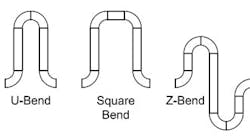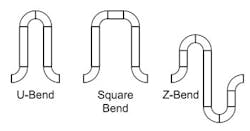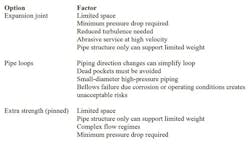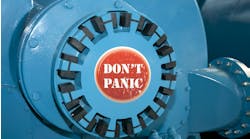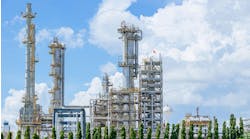Many process plants operate equipment at temperatures well above ambient. The temperature rise during operation may cause significant increases in equipment size or pipe length. Unless allowed to expand, the equipment and pipe may reach the failure point because of internal stresses.
Designers typically rely on three options to deal with the stress:
- expansion joints,
- pipe loops; and
- extra-strong equipment or piping.
Expansion joints commonly use bellows with either external or internal pressurization to allow for pipe flexibility. In general, externally pressurized bellows can accommodate more expansion, can be built to have reduced leakage during a failure and, with proper connections, may be self-draining. Internally pressurized bellows permit easier inspection of the bellows and cost less.
Figure 1. These three configurations often are used to accommodate thermal expansion.
Loops give pipe some freedom to move and grow when heated. Figure 1 shows three of several possible configurations —the u-bend, square bend, and z-bend. If the pipe must change direction anyway, careful pipe layout may accommodate the required growth.
Equipment and piping can be built strong enough by proper selection of materials and their thickness to withstand the stress. One approach is to restrict the stress to the piping and so avoid the need for beefed-up equipment flanges, etc. Special pipe supports can prevent stress from being transferred to equipment.
Materials with a lower coefficient of thermal expansion (α) grow less when heated. Carbon steel has a lower α than stainless steel, which has a lower α than aluminum.
The stress applied goes up as either temperature, α or pipe length increase. Allowable stress will vary with the material and its operating temperature. Carefully check that material selected can cope with the expected stress as well as meet process and economic requirements.
Under some conditions, using thinner piping will significantly reduce stress and still meet pressure- and temperature-rating requirements.
Extra-strength approaches can focus on the ambient temperature or the operating conditions. In one case, a pump casing was specially fabricated and piping built short. This required forcing a fit-up under cold conditions. As the unit heated, the stress in the piping and on the equipment dropped. In another case, the piping was built so that maximum stress occurred under operating conditions. Pins added to the piping prevented transfer of stress to either upstream or downstream equipment. A thin-wall high-alloy line was used to minimize stress during operation.
Table 1. Each option offers advantages for certain situations or constraints.
Table 1 summarizes factors favoring each option. Most times, select an expansion joint or pipe loop. Only use a pinned piping network where both of the other options pose severe problems.
If the system allows for either an expansion joint or pipe loop, economics should drive the decision. The economic analysis should include the costs of pumping, installation, piping (the components themselves and the structure holding them) and any expansion joint.
If you’re using a fixed speed pump, small pressure-drop changes in the piping network are unlikely to save energy. The pressure drop of the flow control valve will change to meet the target flow rates. However, if you’re using a variable speed pump, the expansion joint will have much more favorable economics. Any reductions in pressure drop will show up as lower energy costs.
